
Please see the resource library tab for the lesson document
- Subject:
- World Cultures
- Material Type:
- Lesson Plan
- Author:
- Natalie Proulx
- Date Added:
- 02/27/2017

Please see the resource library tab for the lesson document
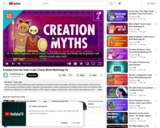
Today on Crash Course Mythology we’re starting in on creation stories. This week, we’ll focus on the creation of the universe out of nothing, or Ex Nihlio creation. Basically, a god decides to make a universe out of nothing. We’ll look at the Genesis story (which has nothing to do with Peter Gabriel or Phil Collins), a Mayan creation tale, a Kono story of the beginning, and we’ll even look at the Big Bang.
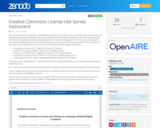
This survey instrument is designed to understand how creators use (or decide not to use) Creative Commons licenses. The target survey participants are people who create materials for documentation, maintenance, instruction, learning, and/or revitalization of Indigenous, minority, endangered, and/or low-resourced languages. Part 1 of this survey is designed to learn about the digital creation formats and sharing practices in this specific community of practice. Parts 2 through 4 of this survey contain general questions intended to elicit information about research participants’ knowledge and awareness of Creative Commons (CC) licenses; understanding of how to apply CC licenses to their digital creations; interest in and experience with applying CC licenses to their digital creations; motivations for and barriers to applying CC licenses to their digital creations; and understanding of how to adapt or reuse digital creations licensed with CC licenses.
This survey can be easily adapted for use in other communities of practice by editing some of the questions and multiple-choice responses.
If you wish to read this survey and background information about it, please start with the file ReadMe-CCLuseSurvey.pdf.
The file Creative_Commons_License_Use_Survey.qsf is a Qualtrics Survey File that can be used to recreate this survey in your own instance of the Qualtrics software.
The file Creative_Commons_License_Use_Survey.pdf is a PDF of the survey. This version includes Creative Commons graphics that are used in the survey questions. The file ReadMe-CCLuseSurvey.pdf does not include the graphics.
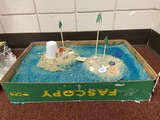
Used as an introductory activity in an Exploratory Makerspace and STEAM class, this project is designed to be an introduction to using all steps of the Design Process. Students will work through these steps to identify the problem, imagine a solution, create a plan, build (an island), test and evaluate their solutions.After we talk about these six steps, students are encouraged to solve the simple problem of building an island. As an instructor, I emphasize that this can be any type of island using any materials we have available, encouraging strong personal choice.

Cree Code Talker reveals the role of Canadian Cree code talker Charles ‘Checker’ Tomkins during the Second World War. Digging deep into the US archives it depicts the true story of Charles’ involvement with the US Air Force and the development of the code talkers communication system, which was used to transmit crucial military communications, using the Cree language as a vital secret weapon in combat.
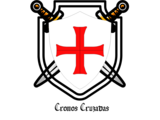
El videojuego propuesto consta de actividades dinámicas las cuales permiten mantener por más tiempo los niveles de motivación de los estudiantes en contraste con el uso exclusivo de recursos tradicionales, donde es más difícil prolongar el tiempo de motivación de los estudiantes.

A little understanding can go a long way. After learning about difficulties that Palestinian youths face, students will write a letter to an official discussing these issues.
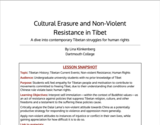
This lesson uses lectures, discussions, and hands-on activities to encourage students to empathize with the Tibetan people and to think critically about responses to the Chinese Communist Party’s oppressive policies. The lesson begins with an overview of Tibetan Buddhism, Tibetan history since the Chinese invasion, and religious policy in China. Next, students actively interpret instances of self-immolation and analyze non-violent strategies for resolving conflict, connecting these subjects to their learning about Tibetan Buddhism and their prior knowledge of non-violent resistance. The lesson concludes with a reflection in which students connect the lesson’s topics to circumstances in their own lives.
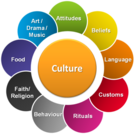
This OER Lesson plan/unit was created by Danielle Fulcher as part of the 2023 World Language OER Summer work and training. Educators worked with NDE staff to create OER Learning Plans and materials. The attached Lesson Plan is designed for 9 - 12 World Language Arts teachers for student learning of Novice-Mid Learners of Spanish. This is a lesson to introduce the concept of culture to novice level Spanish students. Using the analogy of the "cultural iceberg" students take a closer look at what culture is and to which cultures they belong. We go further by taking a look at greetings in their own culture and comparing them to greetings in Spanish-speaking countries. Students are able to define what a typical greeting looks like and what influences how those greeting rituals look on the surface. This resource comes with a pdf of a slideshow with information and a pdf worksheet for your students to analyze the concept of culture.This Lesson Plan addresses the following NDE World Language Standard(s): NE WL 2.1.b, 2.2.bIt is expected that this Lesson Plan will take students 50 minutes to complete.

This video examines how culture affects emotions.
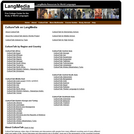
CultureTalk - Arab World features a very extensive selection of filmed interviews with people from different countries in the Arabic speaking world. While some interviews are in English, the vast majority are in Arabic. Translations and usually transcripts are provided for all non-English video clips. Topics include family, food, education, religious and cultural customs, work, art, sport, travel, etc. The regions covered are the Levant, North Africa, Egypt, and Mauritania, with an Iraqi section on the way.
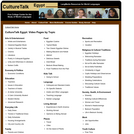
CultureTalk - Arab World features native speakers from across the Arabic-speaking world giving filmed interviews, in Arabic and sometimes English, on selected topics. Text-based translations and transcriptions are often provided as downloadable documents for most Arabic videos. The videos engage a number of region/country-specific topics, including cultural traditions, religion, politics, and sports.
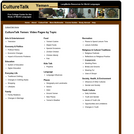
CultureTalk - Arab World features native speakers from across the Arabic-speaking world giving filmed interviews, in Arabic and sometimes English, on selected topics. Text-based translations and transcriptions are often provided as downloadable documents for most Arabic videos. The videos engage a number of region/country-specific topics, including cultural traditions, religion, politics, and sports.
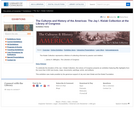
Features 50 highlights from rare books, maps, paintings, and artifacts. The exhibit explores pre-Columbian cultures of Central America and the Caribbean, encounters between Europeans and indigenous peoples, the growth of European Florida, and piracy and trade in the American Atlantic. Highlights include Columbus's account of the 1492 voyage, Frances Drake's maps, the first natural history of the Americas, and a 7th century wooden box that recorded Mayan dynastic lineage.
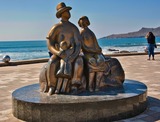
Just figuring it out as we go along
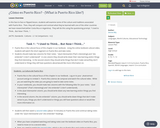
In this face to face or flipped lesson, students will examine some of the culture and traditions associated with Puerto Rico. Then, they will compare and contrast what they've learned with one of the other countries we have researched (either Costa Rica or Argentina). They will do this using the questioning prompt, "I Used to Think... But Now I Think...".(ACTFL Standards: Cultures - 2.1 & Comparisons - 4.2)

Georgina Drapeau and Mat Pendleton of the Lower Sioux Indian Community talk about the revival of quill working traditions taking place in the Minnesota River Valley, inspired by master quill workers Hope TwoHearts of Cansayapi and David Louis of Flandreau, South Dakota.
A lesson plan for grades 7-12 is included as a gallery asset and in the support materials.
More About This Resource
Daughter of a master quill artist, Georgina Drapeau and Mat Pendleton of the Lower Sioux Indian Community near Morton are interviewed for a story about a revival of quill working traditions taking place in the Minnesota River Valley, inspired by master quill workers Hope TwoHearts of Cansayapi and David Louis of Flandreau, South Dakota.
Pieper Bloomquist uses natural materials and homemade paints in the Swedish styles of Dalmålning and Bonadsmålning. She studied under master artists Karen Jenson of Milan, MN and Judith Kjenstad of Minneapolis, MN and works from her studio in Grand Forks, ND.
Postcards is an award-winning series showcasing the arts, history, and cultural heritage of western Minnesota and beyond. Funding for Postcards comes from the Minnesota Arts and Cultural Heritage Fund. To watch more Postcards visit our show page or video portal.
Pioneer PBS is a viewer-supported television station dedicated to sharing local stories of the region with the world. Support our mission and become a member at here.
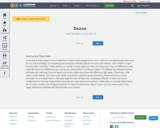
In the world today there is a lot of attention to dance many people love to do it. Some do it professionally some do it for fun and socializing. For socializing and having fun the best dances are social latin dances. One of them is salsa and the other is bachata. These dances are similar in some ways but there are many ways they are different as well. I will talk about the differences now and let you choose which one fits you better. The differences between bachata and salsa are really big! If you’ve heard Latin music before you know the difference right away. The timing is the same in both dances, but salsa music tends to be faster y picante (spicy), bachata is slower and kind of suave (smooth), it’s a romantic dance. The basic steps for each of them are completely different. In salsa you have a straight line for the basic steps while in bachata you have latteral movements. Unlike salsa, in bachata dance there are no turns, instead, you bring your partner in close the whole time. Now it is your turn you know some of the major differences between two dances select one of them.

Overview
This course was created as an Open Educational Resource by a team from the University of Maryland Baltimore County. It is available for your adoption and adaption under a CC by license.
Dance History- Cultural and Classical Forms introduces dance forms over a broad time period covering prehistory through the late 19th century. Students will investigate dance forms from many parts of the world and the encounters between indigenous and colonial forms. Information will be presented through lectures, video, slides, discussions, peer & group presentations & projects, as well as, embodied small movement investigations and larger movement investigations at the dance studio.
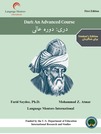
The Advanced Student's Edition of our Dari textbook series presents a comprehensive strategy for enhancing Dari language competencies, such as speaking, writing, listening, and reading. Integral to our proficiency-oriented Dari educational offerings for adults, this edition is designed for learners at ACTFL's Intermediate High/Advanced Low or ILR levels 1+/2. It promotes critical thinking and incorporates educational methodologies like Bloom's Taxonomy to support intellectual development. With interactive exercises in PDF and EPUB formats accessible on the LMI website (languagementors.org), this edition ensures an engaging and interactive learning experience.